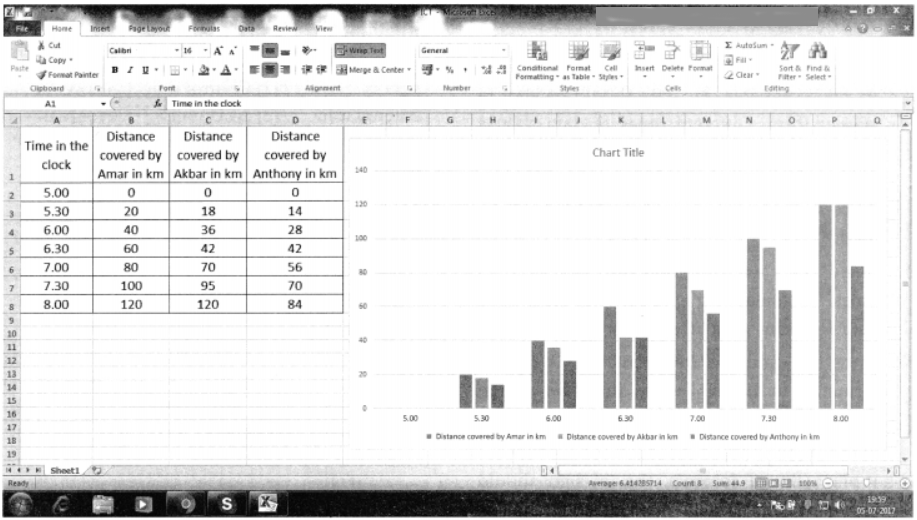Information Communication Technology
Solutions
1. Fill in the blanks to complete the statements. Justify the statements.
2. Answer the following questions.
a. Explain the role and importance of information communication in science and technology.
Answer:
- ICT plays a key role in creating, displaying, collecting, processing and communicating information in the field of science and technology.
- Following is the importance of ICT in science and technology:
(a) Access to wide range of information
(b) Storing of Data
(c) Processing of Data
(d) Securing work files
(e) Proper representation of data
b. Which application software in the computer system did you find useful while studying science, and how?
Answer:
- Microsoft word: To write down the information collected and making a document for further evaluation.
- Microsoft excel : To draw graph based on the obtained numerical information from the experiment.
- Internet explorer: To search for information in finding out the solution or solving the queries by reading the available information.
c. How does a computer work?
Answer:
| Input unit | Processor | Output Unit |
| All types of information/ data is entered into the computer through this unit. Generally, a keyboard is used to enter data or information | Processing Unit (1) Memory unit (2) Control unit (3) ALU unit | The result/solution/ answer is eventually sent to the output unit. Generally, a screen/monitor or printer is used as an output unit. |
d. What precautions should be taken while using various types of software on the computer?
Answer:
- Antivirus must be installed.
- Software should be legal and from a trusted place.
- Application should be scanned before using.
- Pirated Software should not be used.
- Provide all necessary data to obtain the best possible results.
e. Which are the various devices used in information communication? How are they used in the context of science?
Answer:
- Various devices used in information communication are: Computers, Laptops, Mobiles, Radios, Television, etc.
- Computers, Laptops and Mobiles: Help in accessing, collecting, processing, communicating, sharing and storing of information. It helps in determining the appropriate conclusions in all fields, including the field of science.
- Television: Help in getting information about the new and innovative technology.
3. Using a spreadsheet, draw graphs between distance and time, using the information about the movements of Amar, Akbar and Anthony given in the table on page 4, in the lesson on Laws of Motion. What precautions will you take while drawing the graph?
Answer:
Precautions to be taken while drawing a graph:
- The data should be kept in tabular form.
- Whenever there is ‘drag and fill’ option used, ‘smart tag’ option should be used after ‘drag data’ to fill data as required.
- Entered data should be formatted in the manner required.
- Various types of graphs can be created by using the same data, so appropriate graph should be selected.
- Chart titles and axes titles should be updated as per the data.
4. Explain the differences between the different generations of computers. How did science contribute to these developments?
Answer:
Generation: 1st
Time Period: 1946 – 1956
Development: Vacuum Tubes Characteristics:
- Huge in size
- Expensive
- Lot of electricity consumption
- Heat generation
Generation: 2nd
Time Period: 1956 – 1963
Development: Transistors
Characteristics:
- Frequent shutdowns
- Superior to 1st Generation
- Small in size and fast
- Cheaper as compared to 1st Generation
- Less consumption of electricity
Generation: 3rd
Time Period: 1963 -1971
Development: IC
Characteristics:
- Keyboards and monitors
- OS
- Smaller and still cheaper
Generation: 4th
Time Period: 1971 – 2010
Development: Microprocessor Characteristics:
- Use of Internet
- GUI
- Introduction of portable devices like mobiles, laptops, etc.
Generation: 5th
Time Period: 2010 – Till Date
Development: Artificial Intelligence (AI) Characteristics:
- Voice recognition
- Sensors
- Nano technology
1st Generation computers occupied the entire room, but due to advancement in science and technology, today’s computer fits into our pockets.
Initially computers needed a specific language to interact but today we use voice recognition for the same.
In these ways, science has contributed in making the computers faster, smaller, cheaper and much more useful.
1st Generation computers occupied the entire room, but due to advancement in science and technology, today’s computer fits into our pockets.
Initially computers needed a specific language to interact but today we use voice recognition for the same.
5. What devices will you use to share with others the knowledge that you have?
Answer:
Devices like radios, televisions, pendrives, computers, laptops, mobiles, landlines, hard drives, CDs, memory cards help us in sharing our knowledge with others.
6. Using information communication technology, prepare powerpoint presentations on at least three topics in your textbook. Make a flowchart of the steps you used while making these presentations.
Answer:
Steps for preparation of PowerPoint presentations:
7. Which technical difficulties did you face while using the computer? What did you do to overcome them?
Answer:
- Lagging: Due to lot of applications running at the same time, the computer starts lagging and becomes slow. Closing a few applications helped solve the problem of lagging.
- Viruses and Bugs: Cybercrimes are rising daily, even from single mail the computer can be attacked by viruses. Installing a valid antivirus helps solve the problem of viruses and bugs.
- Breach of Privacy: Confidential information being accessed by anyone is the breach of privacy. Putting privacy setting in place helps solve the problem.
- Physical Damage: Hardware over a period of time might get physically damaged. Taking precautions while using will help to solve the problem.



Leave a Reply